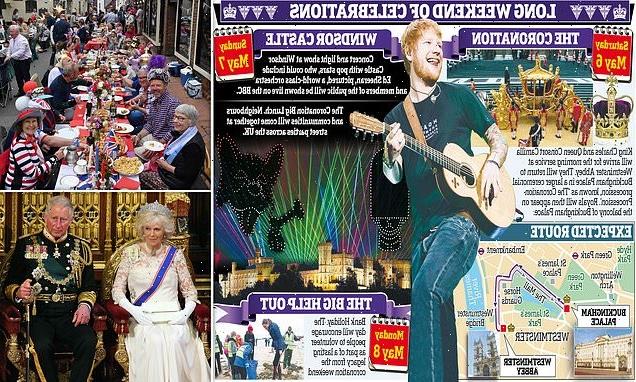
Spectacular, epic… but don’t expect King Charles’ coronation to have the grandeur of 1953: ROBERT HARDMAN looks forward to three days of celebration the crowning of the new monarch
Though it will not have a cast on the scale of 1953 – and it will undoubtedly be better organised than, say, the chaos of 1821 – the coronation of Charles III will certainly set a new record in one regard: Inclusivity.
Both inside and especially outside Westminster Abbey, this event will break new ground.
Historically, coronations have restricted audience participation to the odd affirmation from the aristocracy.
Indeed, it was not until the last coronation that the congregation (chiefly hereditary peers) were even permitted to sing. They were allowed to join in a single hymn – All People That On Earth Do Dwell.
ROBERT HARDMAN: The coronation of Charles III will certainly set a new record in one regard: Inclusivity. Both inside and especially outside Westminster Abbey, this event will break new ground
It was only after a long campaign by the Press and others that the authorities grudgingly agreed to allow television cameras to capture the proceedings for the first time.
Look ahead to May and we can already see a clear emphasis on thinning down the VIP quota to include a large cross section from the voluntary sector.
Much has been made of the fact that the congregation will be around 2,000 people, a quarter of the 8,000-plus in 1953.
The Westminster Abbey authorities had erected miles of scaffolding last time to create internal grandstands. Not only would those breach every modern health and safety regulation. They would also reduce the majesty and grandeur of the event for the average TV viewer.
Community choirs will be included as part of Charles’ coronation in addition to orchestras
Give peers, MPs and the Civil Service a modest ration of tickets and a lottery. Then, at a stroke, the numbers shrink right down anyway.
The substance of this weekend’s latest announcements from the Palace, however, involves events beyond the Abbey.
We are told that there will be two separate processions – one to and one from the service. My understanding is that the slow and unwieldy Gold State Coach will feature in only one of them and that the return journey will not retread the path of 1953.
Back then, the procession home to the Palace meandered around London’s West End for five miles. It took 45 minutes for it to pass any one spot because it involved almost 35,000 marching troops and another 16,000 lining the route.
Modern Britain certainly expects something spectacular and epic –plus the mandatory balcony appearance – but we have neither the inclination nor the manpower for a post-imperial military carnival on 1953 lines.
On the day after the coronation, communities everywhere will be encouraged to hold a Coronation Big Lunch, echoing the Queen’s Platinum Jubilee
Instead, there will be a major focus on national celebrations over the following two days. In 1953, the celebrations were confined to one day. This time, events will be co-ordinated across a long weekend, concluding with The Big Help Out, a celebration of the entire voluntary sector. On the day after the coronation, communities everywhere will be encouraged to hold a Coronation Big Lunch, echoing the Queen’s Platinum Jubilee.
That evening, Windsor Castle will stage a spectacular Coronation Concert, broadcast live on the BBC, followed by a drone-based light show (fireworks, alas, seem to have had their day).
‘Expect some Shakespeare,’ says one of the organisers, mindful of the King’s ties with the Royal Shakespeare Company.
Every sort of community choir – from refugees to the LGBTQ+ world – will be included, along with some of our leading orchestras. ‘Think more Classic FM than Radio 1 or 2,’ I am told.
Perhaps we might even see one member of the 1953 Westminster Abbey choir who still performs in public from time to time. I am sure the organisers could find a space for The Rolling Stones’ Keith Richards.
Source: Read Full Article


